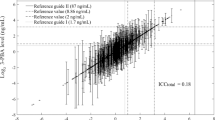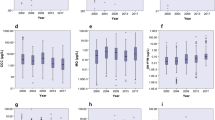Abstract
Widespread application of contemporary-use insecticides results in low-level exposure for a majority of the population through a variety of pathways. Urinary insecticide biomarkers account for all exposure pathways, but failure to account for temporal within-subject variability of urinary levels can lead to exposure misclassification. To examine temporal variability in urinary markers of contemporary-use insecticides, nine repeated urine samples were collected over 3 months from 10 men participating in an ongoing study of male reproductive health. These 90 samples were analyzed for urinary metabolites of chlorpyrifos (3,5,6-trichloro-2-pyridinol (TCPY)) and carbaryl (1-naphthol (1N)). Volume- based (unadjusted), as well as creatinine (CRE)- and specific gravity (SG)-adjusted concentrations were measured. TCPY had low reliability with an intraclass correlation coefficient between 0.15 and 0.21, while 1N was moderately reliable with an intraclass correlation coefficient between 0.55 and 0.61. When the 10 men were divided into tertiles based on 3-month geometric mean TCPY and 1N levels, a single urine sample performed adequately in classifying a subject into the highest or lowest exposure tertiles. Sensitivity and specificity ranged from 0.44 to 0.84 for TCPY and from 0.56 to 0.89 for 1N. Some differences in the results between unadjusted metabolite concentrations and concentrations adjusted for CRE and SG were observed. Questionnaires were used to assess diet in the 24 h preceding the collection of each urine sample. In mixed-effects models, TCPY was significantly associated with season as well as with consuming grapes and cheese, while 1N levels were associated with consuming strawberries. In conclusion, although a single sample adequately predicted longer-term average exposure, a second sample collected at least 1 month following the first sample would reduce exposure measurement error.
This is a preview of subscription content, access via your institution
Access options
Subscribe to this journal
Receive 6 print issues and online access
$259.00 per year
only $43.17 per issue
Buy this article
- Purchase on Springer Link
- Instant access to full article PDF
Prices may be subject to local taxes which are calculated during checkout
Similar content being viewed by others
Abbreviations
- CDC:
-
Centers for Disease Control and Prevention
- CRE:
-
creatinine
- EPA:
-
US Environment Protection Agency
- FDA:
-
Food and Drug Administration
- ICC:
-
intraclass correlation coefficient
- NHANES:
-
National Health and Nutrition Examination Survey
- NHEXAS:
-
National Human Exposure Assessment Study
- NWS:
-
National Weather Service
- RSD:
-
relative standard deviation
- SG:
-
specific gravity
- TCPY:
-
3,5,6-trichloro-2-pyridinol
- USDA:
-
U.S. Department of Agriculture
- 1N:
-
1-naphthol
References
Adgate J.L., et al. Measurement of children's exposure to pesticides: analysis of urinary metabolite levels in a probability-based sample. Environ Health Perspect 2001: 109: 583–590.
Barr D.B., et al. Strategies for biological monitoring of exposure for contemporary-use pesticides. Toxicol Ind Health 1999: 15: 168–179.
Beaton G.H., et al. Sources of variance in 24-hour dietary recall data: implications for nutrition study design and interpretation. Am J Clin Nutr 1979: 32: 2546–2549.
Berger-Preiss E., et al. The behaviour of pyrethroids indoors: a model study. Indoor Air 1997: 7: 248–261.
Berkowitz G.S., et al. Exposure to indoor pesticides during pregnancy in a multiethnic, urban cohort. Environ Health Perspect 2003: 111: 79–84.
Boeniger M.F., et al. Interpretation of urine results used to assess chemical exposure with emphasis on creatinine adjustments: a review. Am Ind Hyg Assoc J 1993: 54: 615–627.
Box G.E., et al. Statistics for Experimenters. John Wiley & Sons, New York, 1978.
Bravo R, et al. Determination of phenolic pesticide metabolites in human urine using gas chromatography-tandem masss spectrometry and isotope dilution quantification. J Anal Toxicol 2004, (in press)..
Buck R.J., et al. Modeled estimates of chlorpyrifos exposure and dose for the Minnesota and Arizona NHEXAS populations. J Expos Anal Environ Epidemiol 2001: 11: 253–268.
Buckley T.J., et al. Environmental and biomarker measurements in nine homes in the Lower Rio Grande Valley: multimedia results for pesticides, metals, PAHs, and VOCs. Environ Int 1997: 23: 705–732.
Byrne S.L., et al. Potential chlorpyrifos exposure to residents following standard crack and crevice treatment. Environ Health Perspect 1998: 106: 725–731.
Camann D.E., et al. Distributions and quality of pesticide, PAH, and PCB measurements in bag dust from four areas of USA. Proceedings, Indoor Air, 2002, pp. 860–864.
Carroll R.J., et al. Measurement Error in Nonlinear Models. CRC Press, New York, 1995.
CDC. Second National Report on Human Exposure to Environmental Chemicals. Centers for Disease Control and Prevention. Washington, DC. 2003. http://www.cdc.gov/exposurereport/2nd/report_results.htm August 2004.
Echols S.L., et al. Temporal variability of microenvironmental time budgets in Maryland. J Expos Anal Environ Epidemiol 1999: 9: 502–512.
Elkins H.B., et al. Concentration adjustments in urinalysis. Am Ind Hyg Assoc J 1974: 35: 559–565.
EPA. Pesticides Industry Sales and Usage: 1996 and 1997 Market Estimates. Report # 733-R-99-001. United States Environmental Protection Agency, Washington, DC, November, 1999.
FDA. Summary of residues found, ordered by food: Market baskets 91-301-04. United States Food and Drug Administration Total Diet Study, Rockville, MD. 2003. http://www.cfsan.fda.gov/∼acrobat/TDS1byfd.pdf August 2004.
Fenske R.A., and Elkner K.P. Multi-route exposure assessment and biological monitoring of urban pesticide applicators during structural control treatments with chlorpyrifos. Toxicol Ind Health 1990: 6: 349–371.
Fenske R.A., et al. Children's exposure to chlorpyrifos and parathion in an agricultural community in central Washington State. Environ Health Perspect 2002: 110: 549–553.
Gordon S.M., et al. Residential environmental measurements in the national human exposure assessment survey (NHEXAS) pilot study in Arizona: preliminary results for pesticides and VOCs. J Expos Anal Environ Epidemiol 1999: 9: 456–470.
Griffin P., et al. Oral and dermal absorption of chlorpyrifos: a human volunteer study. Occup Environ Med 1999: 56: 10–13.
Hauser R., et al. The relationship between human semen parameters and environmental exposure to polychlorinated biphenyls and p,p′-DDE. Environ Health Perspect 2003: 111: 1505–1511.
Hill Jr R.H., et al. Pesticide residues in urine of adults living in the United States: reference range concentrations. Environ Res 1995: 71: 99–108.
Kieszak S.M., et al. Investigation of the relation between self-reported food consumption and household chemical exposures with urinary levels of selected nonpersistent pesticides. J Expos Anal Environ Epidemiol 2002: 12: 404–408.
Krieger R.I., et al. Biomonitoring of persons exposed to insecticides used in residences. Ann Occup Hyg 2001: 45 (Suppl. 1): S143–53.
Kutz F.W., et al. Selected pesticide residues and metabolites in urine from a survey of the U.S. general population. J Toxicol Environ Health 1992: 37: 277–291.
Lewis R.G. Pesticides. In: Spengler J.D., Samet J. (Eds.). Indoor Air Quality Handbook. McGraw-Hill Publishers, New York, 2000, pp. 35: 1–35:21.
Lu C., and Fenske R.A. Air and surface chlorpyrifos residues following residential broadcast and aerosol pesticide applications. Environ Sci Technol 1998: 32: 1386–1390.
MacIntosh D.L., et al. A longitudinal investigation of selected pesticide metabolites in urine. J Expos Anal Environ Epidemiol 1999: 9: 494–501.
MacIntosh D.L., et al. Longitudinal investigation of dietary exposure to selected pesticides. Environ Health Perspect 2001: 109: 145–150.
Moschandreas D.J., et al. Exposure apportionment: ranking food items by their contribution to dietary exposure. J Expos Anal Environ Epidemiol 2002: 12: 233–243.
Mukerjee S., et al. An environmental scoping study in the Lower Rio Grande Valley of Texas — III. Residential microenvironmental monitoring for air, house dust, and soil. Environ Int 1997: 23: 657–673.
NWS. Monthly mean maximum temperatures for Boston, Massachusetts. National Weather Service Eastern Region Headquarters, Bohemia, NY. 2003. http://www.erh.noaa.gov/er/box/climate/bosmax.shtml August 2004.
Nolan R.J., et al. Chlorpyrifos: pharmacokinetics in human volunteers. Toxicol Appl Pharmacol 1984: 73: 8–15.
Pang Y., et al. Analysis of aggregate exposure to chlorpyrifos in the NHEXAS-Maryland investigation. Environ Health Perspect 2002: 110: 235–240.
Peck J.D., et al. Accuracy of fetal growth indicators as surrogate measures of steroid hormone levels during pregnancy. Am J Epidemiol 2003: 157: 258–266.
Rosner B., et al. Correction of logistic regression relative risk estimates and confidence intervals for random within-person measurement error. Am J Epidemiol 1992: 136: 1400–1413.
Rosner B Fundamentals of Biostatistics. Duxbury Press, Pacific Grove CA, 1999.
Schenk G., et al. Human exposure to airborne pesticides in homes treated with wood preservatives. Indoor Air 1997: 7: 135–142.
Teass A.W., et al. Application of biological monitoring methods. In: Eller P.M. (Ed.). NIOSH Manual of Analytical Methods, 4th edn. US Department of Health and Human Service, Cincinnati, OH, Public Health Service, Centers for Disease Control and Prevention, National Institute for Occupational Safety and Health, Division of Physical Sciences and Engineering., 1998.
USDA. USDA Pesticide Data Program: PDP databases available for downloading. U. S. Department of Agriculture. Washington, DC. 2000. http://www.ams.usda.gov/science/pdp/download.htm August 2004.
Van Staveren W.A., et al. Seasonal variation in food intake, pattern of physical activity and change in body weight in a group of young adult Dutch women consuming self-selected diets. Int J Obes 1986: 10: 133–145.
Whitmore R.W., et al. Non-occupational exposures to pesticides for residents of two US cities. Arch Environ Contamin Toxicol 1994: 26: 47–59.
Whyatt R.M., et al. Residential pesticide use during pregnancy among a cohort of urban minority women. Environ Health Perspect 2002: 110: 507–514.
Willett W.C., et al. Reproducibility and validity of a semiquantitative food frequency questionnaire. Am J Epidemiol 1985: 122: 51–65.
Willett W Nutritional Epidemiology. Oxford University Press, New York, 1998.
Wilson N.K., et al. Aggregate exposures of nine preschool children to persistent organic pollutants at day care and at home. J Expos Anal Environ Epidemiol 2003: 13: 187–202.
Wright C.G., et al. Chlorpyrifos in the air and soil of houses eight years after its application for termite control. Bull Environ Contamin Toxicol 1994: 52: 131–134.
Ziegler R.G., et al. Seasonal variation in intake of carotenoids and vegetables and fruits among white men in New Jersey. Am J Clin Nutr 1987: 45: 107–114.
Acknowledgements
The project described was supported by Grant Numbers ES09718 and ES00002 from the National Institute of Environmental Health Sciences (NIEHS), NIH. Its contents are solely the responsibility of the authors and do not necessarily represent the official reviews of NIEHS, NIH.
Author information
Authors and Affiliations
Corresponding author
Rights and permissions
About this article
Cite this article
Meeker, J., Barr, D., Ryan, L. et al. Temporal variability of urinary levels of nonpersistent insecticides in adult men. J Expo Sci Environ Epidemiol 15, 271–281 (2005). https://doi.org/10.1038/sj.jea.7500402
Received:
Accepted:
Published:
Issue Date:
DOI: https://doi.org/10.1038/sj.jea.7500402
Keywords
This article is cited by
-
Prenatal exposure to organophosphate pesticides, maternal paraoxonase 1 genotype, and childhood neurodevelopment at 24 months of age in Shandong, China
Environmental Science and Pollution Research (2020)
-
Contemporary Issues in Exposure Assessment Using Biomonitoring
Current Epidemiology Reports (2016)
-
Time courses and variability of pyrethroid biomarkers of exposure in a group of agricultural workers in Quebec, Canada
International Archives of Occupational and Environmental Health (2016)
-
Reliability of concentrations of organophosphate pesticide metabolites in serial urine specimens from pregnancy in the Generation R Study
Journal of Exposure Science & Environmental Epidemiology (2015)
-
Environmental exposure to pyrethroids and sperm sex chromosome disomy: a cross-sectional study
Environmental Health (2013)



